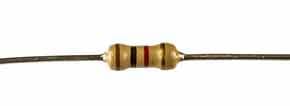Carbon Film Resistor
The carbon film resistor took over from the carbon composition resistor, being smaller and able to provide a much better performance level.
Home » Electronic components » this page
Resistor Tutorial Includes:
Resistors overview
Carbon composition
Carbon film
Metal oxide film
Metal film
Wirewound
SMD resistor
MELF resistor
Variable resistors
Light dependent resistor
Thermistor
Varistor
Resistor colour codes
SMD resistor markings & codes
Resistor specifications
Resistor maximum voltage
Where & how to buy resistors
Standard resistor values & E series
The carbon film resistor, as the name indicates is made from a film of carbon on a ceramic former.
The carbon film resistor took over from the carbon composition resistor, especially as transistor technology started to take over.
The carbon film resistor provides better performance in many respects than the carbon compositing resistor, but this resistor type was overtaken by metal oxide film and metal film resistors which gave even better levels of performance.

What is a carbon film resistor
The carbon film resistor is formed using a ceramic carrier rod onto which a thin layer of pure carbon is deposited as a film. It is the thin carbon film that acts as the resistive element.
To enable the carbon film resistor to have the correct resistance, a helical cut is normally made into the film. This increases the length of the path and also reduces the width of the resistive element.
The resistance is obviously governed by the length of the path, the width of the resistive element, and also the thickness of the deposited carbon film.
In view of the fact that the resistive element forms a coil, these resistors have an inductance and this may affect their operation in RF circuits. The value may reach several µH, although uncut resistors are available and the level of self-induction for these components can be around 0.01 µH.
The capacitance may be around 0.5pF.
The use of pure carbon means that carbon film resistors have a negative temperature coefficient which is higher than that of carbon composition resistors. Typical values may be between -1x10-4 Ω/°C and -8x10-4 Ω/°C.
A further property of the carbon film resistor is that, using pure carbon, the noise produced by the resistor is significantly less than that produced by a carbon composition type.
Carbon film resistor manufacture
carbon film resistors are manufactured using a deposition process. The ceramic rod or carrier is placed in an environment where the temperature and pressure are high. Hydrocarbon gas, typically methane or benzene is passed over the rods at a temperature of around 1000°C. At this temperature the hydrocarbon gas breaks down and a thin film of carbon is deposited onto the rods.
Once the rods have been obtained, end caps are placed onto the rods to connect to the carbon film, and the resistance value may be trimmed by making a helical cut in the carbon.
Once complete, the resistors are coated in a resin to protect the resistive element from handling as well as increases of moisture and other contaminants.
Typical carbon film resistor specifications
Typical performance figures for carbon film resistors are given below as a guide to the performance
| Carbon Film Resistor Performance Guide | |
|---|---|
| Carbon Film Resistor Parameter | Carbon Film Resistor Performance |
| Typical tolerance availability | ±2%, ±5%, ±10%, ±20% |
| Value range | <1Ω - ~10MΩ |
| Load life (% change over 1000h) | 2 |
| Max noise (µV/V) | 20. |
| Temperature coefficient (ppm/°C) | ±200 - >±1500 |
| Voltage coefficient (%/V) | 0.0005 |
| Max resistor temperature (°C) | 150 |
 Written by Ian Poole .
Written by Ian Poole .
Experienced electronics engineer and author.
More Electronic Components:
Batteries
Capacitors
Connectors
ADC
DAC
Diodes
FET
Inductors
Memory types
Phototransistor
Quartz crystals
Relays
Resistors
RF connectors
Switches
Surface mount technology
Thyristor
Transformers
Transistor
Unijunction
Valves / Tubes
Return to Components menu . . .


